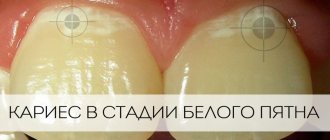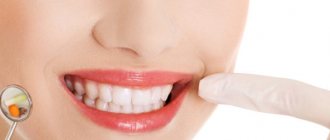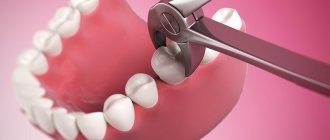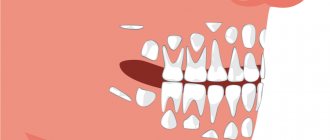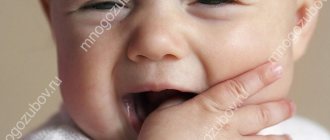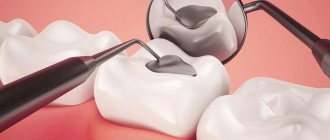The main diseases of primary teeth in children
| Disease | Description |
| Caries | This insidious disease does not manifest itself in any way at the initial stages. Caries eats away dentin from the inside, and over time a cavity forms in it. Severe pain and bad breath occur, and if left untreated, the infection spreads to adjacent teeth. A child’s tooth enamel is much thinner than an adult’s, so it is more susceptible to destruction. |
| Pulpitis | It is characterized by inflammation of the pulp, a bone substance covered with enamel. In pediatric dentistry, acute and chronic pulpitis are distinguished. Symptoms of pulpitis: pain when biting, swelling of soft tissues, fever. Treatment consists of removing the affected bone tissue. |
| Stomatitis | The disease affects the mucous membrane of the mouth. Ulcers form, which can be located on the gums, inner surface of the cheeks, and palate. Also, with stomatitis, a white coating appears in the mouth, and pain in the lymph nodes may occur. |
Good to know. Compliance with preventive measures is the simplest and at the same time reliable method of combating caries.
To protect children's teeth from further damage, it is necessary:
- make sure that there are no cracks on them, which become “gates” for caries-forming bacteria (cracks usually occur as a result of injuries);
- maintain oral hygiene, which will prevent the formation of plaque (the child should brush his teeth twice a day with age-appropriate toothpaste);
- supplement the menu with protein products that help strengthen enamel, as well as seasonal vegetables and fruits;
- if this is not possible, select a vitamin-mineral complex with the help of a pediatrician.
Non-carious diseases
| Disease | Description |
| Enamel hypoplasia | Pathology occurs as a result of metabolic disorders in dental tissues and manifests itself in the form of round-shaped spots or depressions in the enamel of various diameters and depths. If permanent teeth erupt with this pathology, then you should not expect it to disappear spontaneously. Often hypoplasia remains for life. |
| Hyperplasia | The disease manifests itself in the form of excessive formation of tartar. Most often they are located in the neck of the tooth. |
| Enamel erosion | Characterized by progressive loss of dental tissue. It occurs against the background of general disorders in the body, with simultaneous physical and chemical effects of local factors. |
| Tissue necrosis | The disease manifests itself as a change in the color of tooth enamel; over time, it loses its shine and becomes rough. Teeth become set on edge, and a painful reaction to thermal irritants appears. |
| Pathological abrasion | It is characterized by increased loss of dental tissue and disruption of the anatomical shape of the tooth crown. |
Causes
Caries in the age category up to 5-10 years develops for various reasons:
- Improper hygiene – pathogenic bacteria accumulate in the oral cavity, which multiply and lead to damage to the enamel.
- A large amount of sweets in the diet – sugar remains on the teeth and promotes the growth of bacteria.
- Early use of antibiotics - some medications change the color of the enamel.
- Poor absorption of calcium by the body.
- Heredity.
- Dysbacteriosis.
- Chronic diseases.
- Insufficiently formed enamel.
- Improper diet - deficiency of vitamins, minerals, fats leads to darkening of teeth due to specific plaque.
Why do children's enamel deteriorate?
The following factors contribute to the destruction of tooth enamel:
- addiction to carbonated drinks;
- frequent consumption of fruit juices;
- insufficient salivation and dry mouth;
- diseases of the gastrointestinal tract;
- use of aspirin, antihistamines;
- hereditary predisposition;
- consuming large amounts of starch and sugar-containing foods.
It is important to know. The beginning of the process of enamel destruction is indicated by the following signs: increased tooth sensitivity, the occurrence of cracks and chips, and changes in the color of the enamel.
How does childhood dental caries occur?
According to statistics, caries in children under three years of age occurs in 90% of cases, that is, 9 out of 10 children have dental caries. This term refers to the pathological, slow process of destruction of hard tooth tissue under the influence of unfavorable factors.
In this article
- How does childhood dental caries occur?
- The main causes of dental caries in children 1 year of age
- Features of bottle caries
- A one-year-old child has caries - what to do?
- How will caries be treated for a one-year-old child?
- How is deep caries treated for young children?
- How to prevent caries in one-year-old children: preventive measures
The oral cavity is home to many microorganisms, including cariogenic bacteria. They can ferment sugars into acids that are destructive to dental tissue. When the number of these bacteria in the mouth increases sharply, they produce large amounts of acid, which causes dental caries in the child.
Gum diseases
Gingivitis
This is the most common form of gum inflammation. Gingivitis itself is not dangerous, but if left untreated it quickly progresses to periodontitis. And this is a more serious disease that requires surgical intervention. Gingivitis is characterized by point inflammation of the mucous membrane, but the dental tissues are not affected and the teeth are not destroyed.
Periodontitis
The disease is characterized by destruction of the supporting apparatus of the tooth. The gum gradually moves away from the tooth and a pocket appears in which food debris accumulates. Bleeding, swelling, and excessive sensitivity occur during chewing. Teeth become loose and fall out over time.
Periodontal disease
Pathology occurs due to impaired blood supply to dental tissues, which causes their degeneration. The necks of the teeth become exposed, and the gaps between them increase. The gums swell and begin to slowly deteriorate. Often the inflammation affects both jaws at once. Local treatment will not bring the desired result; complex therapy will be required.
Professional treatments
To stop tooth decay, experts recommend strengthening the enamel with the help of remineralizing agents:
- fluoridation – periodic coating with solutions containing fluorine and other useful microelements;
- artificial saturation of the enamel surface with calcium and other minerals - the dentinal tubules are sealed and the density of the enamel increases;
- ozonation – destruction of bacteria in the affected tooth tissues without injuring soft tissues, helps stop destruction and cure caries at the initial stage;
- filling of dental defects;
- prosthetics – a decaying tooth is covered with a crown to isolate it from aggressive environments and stop crumbling.
- fissure sealing – sealing the chewing surface of molars with a special filling material;
The dentist chooses the appropriate treatment method, depending on the condition of the teeth and the age of the patient.
If your teeth have already begun to decay/crumple or the first signs of caries have appeared (stains on the enamel, changes in its color), do not delay your visit to the dentist. This is when time matters!
Methods of treating diseases
When treating primary teeth, doctors often have to abandon standard methods and use more gentle methods. The fact is that the amount of anesthesia for children is much less than for adults, and doctors try not to harm patients. Children also need to be provided with comfortable conditions for treatment.
Caries treatment is carried out using the following methods:
- silvering;
- remineralization;
- ozone therapy;
- filling;
- dipophoresis;
- dissection.
It is important to know. Children at an early age often swallow toothpaste while brushing their teeth, so it should not contain fluoride.
The Saint-Dent Clinic provides all types of dental treatment for adults and children. Prices for dental services are indicated in the price list; you can view it here PRICES FOR SERVICES. Contacts of the clinic are posted here CONTACTS.
Effective prevention of caries
What else can be done if a child has bad baby teeth? Engage in prevention. It is very important to teach your baby to rinse his mouth after every meal in order to remove sources of bacteria from the oral cavity as often as possible. A child should brush their teeth under the supervision of an adult, and even better if mom or dad does this for a while.
It would be a good idea to remove candies, toffees and other sweets from the diet, and instead introduce your baby to cottage cheese, hard cheese, fish, sour cream, and eggs. The child should spend enough time in the air and get his portion of sunlight - a source of vitamin D. All this together will help protect the teeth from further destruction.
How is deep caries treated for young children?
If a one-year-old child is diagnosed with deep caries, it cannot be treated like a superficial one, without drilling. In this case, the teeth are filled with photopolymer composite or glass ionomer cement. To ensure that the baby sits still or as calm as possible during treatment, sedation or general anesthesia is used. Unfortunately, any anesthesia has a number of side effects, so it is better not to start caries and treat it in the early stages, when you can do without preparation and filling.
What does dental health depend on?
The enamel on baby teeth is not yet strong and strong enough, so it is susceptible to any mechanical stress. Unfortunately, many adults believe that it is not necessary to treat baby teeth, because they will very soon be replaced by permanent ones. However, such a judgment is fundamentally wrong! The health of molars is directly related to the condition of their predecessors.
The fragility of the enamel may be due to a hereditary factor: perhaps one of your relatives has very fragile teeth that are prone to destruction. Also, factors such as unfavorable environmental conditions in the region of residence, poor-quality tap water, mental health problems and much more can lead to the depletion of a child’s tooth enamel.
An important factor can be a woman’s careless attitude towards her health during pregnancy. In particular, this applies to drinking alcohol and smoking. This negatively affects not only the development of the baby’s bones and teeth, but also his overall health. Also, the cause of tooth decay can be liver pathologies, problems with the thyroid gland, gastrointestinal diseases, etc.
If children's teeth are crumbling...
Teeth change color and become extremely sensitive to hot and cold: as soon as children have permanent teeth, many already suffer from so-called molar hypomineralization (MIH).
This is a special form of disruption of the formation of tooth enamel. First of all, this disease affects the chewing teeth. But incisors can also suffer from this disease.
A lack of minerals makes teeth porous. Teeth affected by MIH have fewer minerals present than are present in healthy teeth. First of all, they have a lower concentration of calcium and phosphates. As a result, teeth become porous, and this, in turn, leads to very rapid development of caries.
When affected molars erupt in schoolchildren, molar hypomineralization is now diagnosed quite simply. But just a few years ago the situation was completely different, since this form of diagnosis simply did not exist yet.
The picture of the disease has only recently been described. It was not until 2001 that this phenomenon was brought together under the term Molar Incisor Hypomineralization (MIH), that is, “mineral deficiency in the molars and incisors.”
This approach has significantly improved the diagnosis of children's and adolescent teeth. After all, before this, it was very difficult for the dentist to determine whether the tooth was porous even before the onset of the disease or whether it was a matter of ordinary caries.
Every tenth child has problems with the formation of tooth enamel. Doctors say that the problem of MIH affects ten percent of children, and in five percent it manifests itself in a severe form, accompanied by significantly increased sensitivity and loss of substance.
In adults, it is much more difficult to assess the extent of molar hypomineralization. Even if they had manifestations of MIH, the teeth affected by this disease in most cases have already undergone treatment and restoration, for which reason an appropriate diagnosis is no longer possible.
The causes of MIH should probably be sought in pregnancy. It has not yet been possible to determine where MIH originates from. Doctors admit that they can only guess about the causes of this disease. For example, problems during pregnancy are considered, which could theoretically have a negative impact on dental development.
In addition, events that occur in early childhood, such as high fever infections, antibiotic use and respiratory diseases, as well as dioxin in breast milk, are also suspected. It is possible that the cause of MIH is a combination of several different factors.
Doctors use different methods to treat molar hypomineralization. If MIH is detected in the early stages, the teeth are usually “sealed,” meaning they are coated with a special compound. In more complex cases, fillers and even crowns are used.
Treatment: special dental care, in some cases – removal. In some severe cases of violations of the formation of tooth enamel, the decision remains with the doctors: does a particular tooth have the prospect of long-term preservation? But if a tooth still has to be removed, it should be taken into account that the issue of filling the vacated space must be resolved as soon as possible, since in this case, due to the increased load, neighboring teeth will also suffer.
And you should remember: if children suffer from problems with the formation of tooth enamel, they should brush their teeth only with soft toothbrushes, using fluoride-containing toothpastes.
My child’s teeth are crumbling, what should I do?
Some parents believe that since baby teeth will eventually fall out anyway, it is not necessary to treat them. This opinion is completely wrong, because the health of the permanent teeth that will replace them largely depends on the condition of temporary teeth.
Diseases of baby teeth lead to their premature loss, which can cause the child to develop an incorrect bite and cause even greater troubles in the future. Therefore, it is very important to show the baby to a specialist in a timely manner, who will help to accurately determine the cause of the problem and prescribe the correct treatment.
I would like to consult with you on what we should do with our teeth. My second daughter is 2 years old, her top two front teeth are terribly falling apart. It started with darkening, we went to the dentist, they said it was caries, but there was no point in doing anything. So they stretched it out, the teeth began to break off in pieces, one of them is now wobbly, I’m in despair, I don’t know what to do. If it falls out, what will happen? The rest will begin to move and most likely the permanent ones will also grow crooked and just as problematic. Now I notice that the top ones, which are nearby, also begin to turn yellow and darken, and become covered with a coating. They did fluoridation, but now I think we can’t do without silvering, we’ll have to go to the regional center, but we should have done it earlier. Are there any other methods to prevent the destruction of children's teeth? And what happens if the tooth does fall out, or if it stays wobbly? Someone says that it can fall out and another one will grow. I don’t know what to do anymore, I’m in a panic. Help me please. With gratitude Nelly. Tobolsk, Tyumen region.
EXPERT'S ANSWER
Hello Nellie! In order to determine why you have such a situation with your teeth, you need, of course, additional information, test results and a direct examination of the child’s oral cavity. Sometimes this is not enough to determine the cause. This is due to our environment, food, water and, of course, genetics, etc. Of course, one cannot leave the situation without control and without appropriate actions. Your daughter is still small and her baby teeth will not be coming out any time soon, so it is very important to save space for the future permanent tooth. If a tooth is removed for some reason, then this is the task of the orthodontist; replacement plates are prescribed. But, from experience, children under 3.5-4 years old do not wear them well. Therefore, it is necessary to try to preserve baby teeth until they are replaced. Deep fluoridation methods are used. We have been using this method for quite some time and the results are very good. But regularity is important here - teeth need to be coated once every 3 or 6 months, according to indications. If this is a one-time procedure or you do it less often than the doctor prescribed for you, then you will not achieve the result. Silver plating is also indicated; your doctor should give you recommendations. In addition, multivitamin preparations and calcium supplements may be prescribed. But this is also according to the doctor’s testimony after getting acquainted specifically with your situation. And, of course, oral hygiene. You should help brush your child's teeth and do so regularly. And as for sweets and sweet juices, I think you yourself know all about it.
Treatment for crumbling teeth
The method of treating tooth decay depends on the cause of this process. If it is caused by general somatic or chronic diseases, the dentist may involve specialized specialists in treatment. In addition, organizing a balanced diet and generally strengthening the immune system are of great importance. To restore damaged teeth, photopolymer filling materials are usually used, and in case of significant destruction, teeth are restored with artificial crowns.
At the ARTOX dental clinic, you can always get advice from a qualified dentist about crumbling teeth in patients of any age and carry out a course of treatment. The experience of our specialists and advanced technologies will allow you to eliminate problems effectively and safely.
Make an online appointment with a doctor or call: +7,.
View prices
Making an appointment with a dentist
What factors worsen the health of baby teeth?
- Mechanical factors: impacts, bruxism, strong compression. They lead to changes in the tooth and disruption of its integrity.
- Chemical factors: prolonged exposure to sweets on the loose enamel of children's teeth.
- Bacterial factor: the spread of bacteria in the baby’s mouth.
- Sudden temperature changes when eating or drinking.

